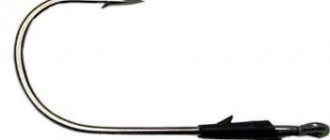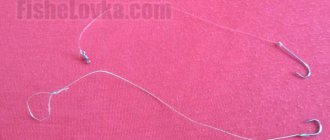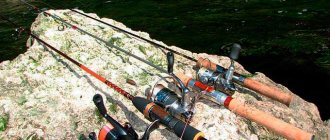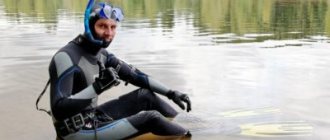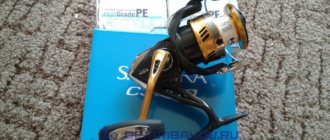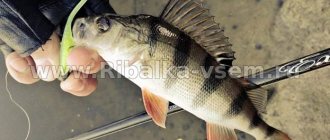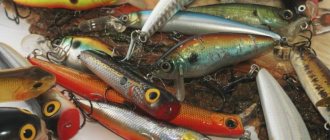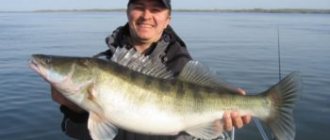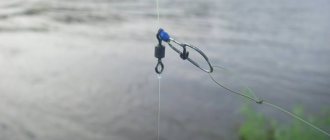Probably every person who has a professional fisherman as a friend knows that he has a huge number of different devices in his arsenal, which includes a lure leash.
The leader is an important component of a successful catch and is the material that connects the hook and line. As has already become clear, in this article we will talk about this device, and also talk about the types of leashes and read consumer reviews.
Requirements for leashes
A pike leash must meet a number of important requirements, because its importance in the reliability of any installation plays a major role. The main requirement for the leader material is its high wear resistance to abrasion, which is precisely what contributes to the conditions for resisting the action of a pike’s mouth, stuffed with teeth as sharp as blades. An important requirement is also considered to be the high breaking load parameters of the material used for the leashes. After all, as you know, pike are the type of fish that never give up when caught without a fierce fight. Another of the main requirements for the accessory is the selection of the optimal length of the leash, which promotes unhindered play of the bait, and is also comparable to the size of the fish’s mouth, preventing it from biting the cord itself when grabbing the bait.
Materials, their advantages and disadvantages
Pike leashes in the classic version are made of steel. The thin core allows it to withstand tearing under heavy loads and resist abrasion. But the disadvantages of steel are its large mass and high levels of residual memory; moreover, at sharp bend angles, the material is prone to creases. Tungsten options are much softer than steel and are not subject to oxidation, but also have high memory and are heavy.
The durable material titanium, from which the lightest, most flexible and memoryless leashes are made, is disappointing only with its high cost, comparable for the price of one unit of titanium leash to the cost of a couple of seasons of active fishing when purchasing accessories made of steel and even tungsten. Kevlar, a synthetic fiber, is increasingly being used in pike fishing, claiming to be a universal leader material. It is plastic, not prone to stretching and has virtually no memory effect. But bulkiness and lack of resistance to sharp teeth hinders the leadership of this type of material. The same can be said about fluorocarbon. The general characteristics of plasticity and high transparency provide obvious advantages for pike fishing and especially for passive fish, but durability requires better results and expectations.
Types of leashes for pike
The leader material affects not only the reliability of the fishing itself, but also the play of baits, which are very diverse in pike hunting, and the methods of mounting live baits also depend to a large extent on the type of this element of equipment. Methods for attaching the accessory to the main cord and mounting the hook may differ depending on the specific design features of the leashes. In continuation of the article, we will take a more specific look at the structural features of the pike mounting equipment based on the material used for the leashes, specifying the fastening elements and the structural structure of the accessory itself.
Steel leashes

Steel is the most common and affordable driving material. In addition, it is characterized by low cost . To produce the product, steel wire up to 0.4 mm thick is used. The length of the steel version of the lead can reach 30 cm. Steel leashes are distinguished by their large mass, and their low plasticity limits the freedom of baits. But at the same time, steel makes it easy to carry out rigs in overgrown areas of water areas, where softer materials get stuck in algae, disrupting the rhythm of the retrieve.
Important! Even thin steel can withstand heavy loads, subsequently, without losing its qualities, but the material is afraid of creases and is susceptible to corrosion, which critically reduces the strength and durability of use.
From thin steel threads, as a result of their weaving and subsequent coating with a polyethylene composition, a driving material is produced, which is characterized by increased ductility and higher performance qualities. Steel bends are equipped with a swivel and fastener.
Titanium
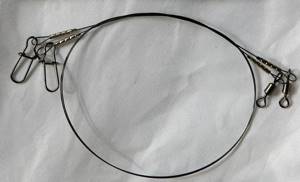
Titanium products are considered to be the most expensive fishing line accessories. This option is characterized by its durability. Titanium is not subject to abrasion and does not corrode in aggressive water environments. Even after a dozen pike attacks, the titanium thread does not change its shape, remaining smooth and unchanged in diameter. Despite significant advantages, titanium leashes are rarely used for pike fishing. As a rule, snags and subsequent irretrievable loss of the rig are common in pike fishing. A spinning pike fisherman has to put up with the fact that leashes are consumables, and the use of an expensive accessory in this situation does not seem like a rational idea.
Kevlar
Kevlar relatively recently appeared on the fishing market and immediately gained its reliable niche in the fishing environment. Synthetic fiber has made it possible to make pike rigs much more flexible and delicate in their sensitivity to predators and their influence on the animation of baits.
Important! Synthetic fiber can withstand high loads without floating in diameter, but it will not always be able to adequately survive a fish attack, being subject to micro cuts and, as a rule, subsequent destruction.
When factory assembled, the product includes a swivel and a carabiner. The length of the accessory ranges from 10–40 cm.
Fluorocarbon
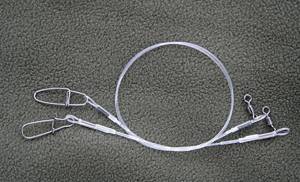
Fluorocarbon line with a diameter of 0.35 mm is an excellent leader material. The transparency of the substance helps the angler to successfully catch passive and cautious fish. Products made from this type of fishing line are distinguished by their lightness, and their plasticity helps artificial baits work within their capabilities. These qualities make it possible to produce fluorocarbon leader mounts of large lengths, over 40 cm, without much concern for the deterioration of the performance of the baits. A negative characteristic of fluorocarbon is its weakness against pike teeth, which is expressed in fairly frequent cuts due to the aggressive behavior of the catfish.
Tungsten
Tungsten products are distinguished by their softness with significantly high breaking load parameters.
Important! This kind of leash has virtually no effect on the animation of the bait, but tungsten is afraid of any small deformations, not returning to its original shape.
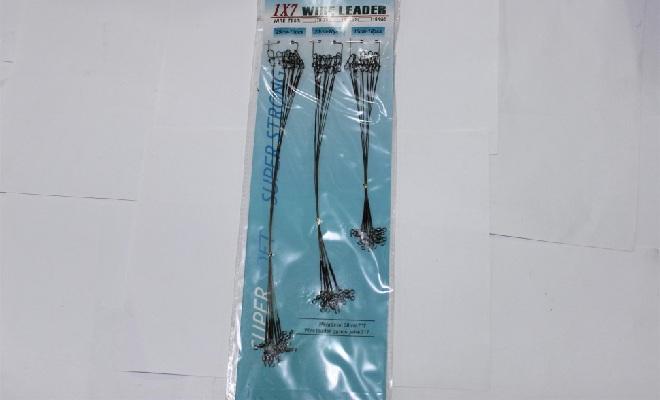
Even the slightest contact of a predator with an accessory renders it unusable, which results in the shape of a pig’s tail, which scares off the trophy with its appearance and prevents the bait from playing. I am pleased with the low cost of the product, and therefore it can be used in a one-time version. Tungsten leashes are equipped with a clasp and a miniature swivel.
Choosing high-quality leader material
The simplest leader material for pike is wire: nichrome, guitar string or specially made for leaders - steel Tooth Proof, copper-nickel Monel Trolling from American Fishing Wire (AFW).
Wire leashes are easy to make, reliable and relatively cheap. In addition, hard wire leaders are necessary for the normal operation of almost all jerkbaits and some stickbaits; they protect against overwhelm when catching pike on spinners with a weight-head. At the same time, such leashes are not suitable for light lures and suspending wobblers.
Although there are exceptions here: a friend gave me two coils of US wire for leashes with a diameter of 0.10 and 0.15 millimeters. What kind of material, which company is unknown. The wire is very elastic and slightly deformed. It looks like titanium: when heated with a lighter, it begins to burn with a bright white flame point. I formed the end loops as a simple knot with double threading. The free end of the wire was tucked into a metal tube, where it was secured with superglue. I had to mobilize all my friends to search for tubes with a diameter of 0.3 - 0.4 millimeters. Subsequently, a solution was found - syringe needles were very suitable for these purposes. Fifteen-centimeter leashes with a diameter of 0.1 millimeters could withstand a load of 2.6 kilograms (we did not hang a larger one), and with a diameter of 0.15 millimeters - 5 kilograms.
About
How to make a leash for a pike with your own hands
It is not difficult to make a leash for a pike with your own hands. For this work, you will need to purchase the material from which the product will be prepared, as well as additional elements for equipping the leashes. The list of additional elements includes: swivels, carabiners or clasps, winding rings and metal tubes of small diameters, which are used for crimping connections. The tools you need to carry out the work include pliers, a sharp knife, scissors, wire cutters and, if possible, an electric screwdriver. In the next part of the article, we will look at the technology for manufacturing driving elements from the most common materials, which can be purchased at a low cost in specialized retail chains.
Special leader material
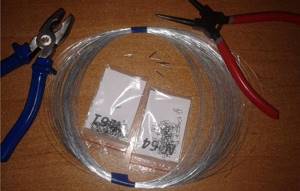
In a fishing store, you can purchase leader material, which is sold in rolls in 1-3 meter sections. Blanks are cut from a long piece of twist, the length of which is calculated based on the working size of the leash and the dimensions required to create two fastening loops at the ends of the product. To form one loop, allow 30 mm.
Important! The loops will be clamped with a crimp tube, the diameter of which must correspond to two diameters of the leading material.
The tube is put on the end of the cut, followed by stringing a swivel onto the workpiece, which will later be used to tie the leash to the fishing line. The remaining tip of the cut is bent and inserted into the tube, bringing out the tip of the material 2–3 mm long from its other side. Now all that remains is to use pliers to crimp the tube in two or three places, making pressure in different planes relative to one another. On the reverse side, exactly the same operation is carried out with the only difference being that instead of a swivel, a clasp is used to wind it into a loop. These simple operations allow you to obtain a plastic and reliable accessory of the size required for fishing conditions.
Steel leash
A steel leash for pike fishing can be made from thin wire, or guitar strings 1 and 2 are ideal for these purposes. The required piece of material is cut off with wire cutters, first taking into account the margin for forming the loop required at both ends of the product. For steel, allowance for hinges is 20–25 mm. Next, bend the tip of the wire into a loop. The radius of the loop should not be less than 3 mm, otherwise the small distance will affect the performance of the fastening and auxiliary element strung on the steel.
A fastener or swivel is inserted into the loop blank, after which a turn is made with the free end around the main wire using round nose pliers. Next, an electric screwdriver will help ease the twisting and make the connection tighter. Having hooked the loop with a hook inserted into the screwdriver chuck, the piece of wire clamped in a vice is twisted until the turns of the free end are completely laid around the base. The same operation is carried out with the second end of the workpiece, inserting the desired auxiliary element into the loop. The lengths of the steel product vary in the range from 10 to 30 cm.
Fluorocarbon
You can make a fluorocarbon leash for a pike using the method of making an accessory from a leash material. For manufacturing, take a piece of fluorocarbon with a thickness of 0.35 to 0.50 mm and select a crimp tube with a diameter double that of the fishing line. The length of the tube itself must be at least 10 cm.
Important! Since fluorocarbon line for pike leashes is much softer than steel leash material, the crimping operation is done especially carefully, paying attention to the crimping force.
The clamp is guaranteed to make an undercut on the fishing line, which will significantly weaken its breaking load. A fluorocarbon product for pike fishing can be prepared in absolutely any size.
Lead material for pike - types, their pros and cons
Flood functionality:
- As a result of using this device, you can very quickly change a hook that might have lost its functionality.
- Inconspicuous in water due to its small size and correctly selected color.
- The leash also protects the rod from breaking.
- The bait moves more naturally.
Varieties:
- Neutral - using lightweight materials.
- Pop-up - used when fishing in overgrown places.
- Hard – the diameter of the leader should be 2 times larger than the bait itself.
- Sinking people lie down on the bottom, where it is clean.
- Combined - several types that are combined into one.
Tungsten
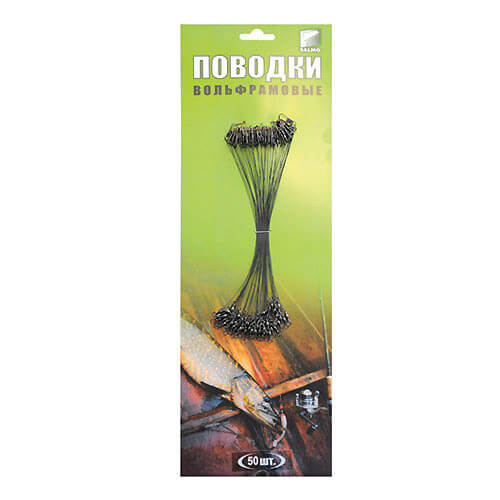
Tungsten is a metal that has a number of unique features, which include:
- Highest boiling point;
- Solid.
Pros of using tungsten in a leash:
- Reliable to use.
- Lightness that will not harm the spinner.
- Low cost.
The only disadvantage can be considered the distortion that can be obtained when catching a large predator. To extend its service life, you can straighten the leash and hold it over an open fire. The price of one meter starts from 40 rubles.
Kevlar
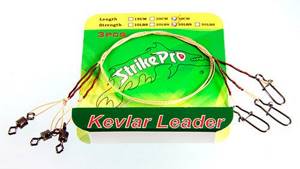
The most popular material from which the flood is made is Kevlar. Despite its softness, it is durable, which gives it maximum uniqueness. Features include remembering the previous form, which remains unchanged even over time.
It can be used in the absence of visibility, namely in muddy water in which nothing is visible. A Kevlar leash will help you catch large pike without effort. The cost of 1 meter is 150 rubles.
Titanium

Titanium is a new material that has not yet gained the trust of consumers. Titanium leashes are strong, which allows you to get a big catch. It is recommended to use with high-quality baits when a break is definitely not the case. In the case of cheap baits, you need to use something different.
Pros:
- Does not deform;
- Lasting;
- Steel is 2 times lighter.
Minuses:
- High price;
- Lack of transparency.
But every day this material is becoming popular among fishermen. The price varies from 100 rubles per 1 meter.
Fluorocarbon
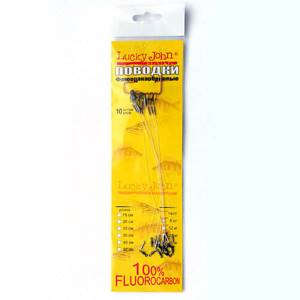
Fluorocarbon leaders are made from a combination of fluorine and carbon. This material is recommended for use in the case of suspicious fish that are afraid of being caught; it is transparent and almost invisible.
Disadvantages may be the large diameter, which does not have the declared properties.
The advantages can be noted:
- Transparency and invisibility.
- Minimum time for immersion in water.
- Can be used at any temperature.
- Maintains appearance.
The diameter of the material depends directly on the weight of the fish.
For example:
- 0.16 mm – 1.5 kg;
- 0.31 more than 5 kilograms.
You can buy from 50 rubles per meter.
Special leader material
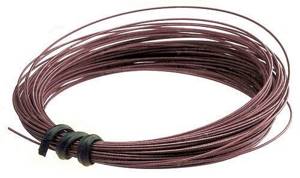
Specialized leader material can be divided into:
Coated material:
A cable made from steel. Suitable for spinners that have more significant weight.
Pros:
- Small price.
- Disguise by choosing the right color.
- Resistant to frequent use.
Minuses:
- Over time it becomes shaggy.
- Has significant weight.
Price starts from 5 rubles per meter, sales are carried out only by footage.
Without cover:
You can use it thanks to:
- Low price.
- It becomes noticeable in water.
There are other aspects to using such a leash:
- Fragility that occurs over time.
- Capricious fish can easily subtract the bait and not bite it.
The most affordable price is from 25 rubles per meter.
Steel leashes

You can purchase it at any store that specializes in fishing, or you can also make it yourself. Can be used in twitching or fishing using a wobbler.
Wobblers are large baits that are made of plastic or wood. The shape and size can be varied. The color doesn't really matter, the deciding factor will be the model.
Advantages of using a steel leash:
- Hardness.
- No option to get confused.
- Low price.
Flaws:
- Volume.
- Poor quality components that can fail at an important moment.
The cost starts from 200 rubles per coil containing 0.069 millimeters.
How to tie correctly
The strength and reliability of pike rigging depends no less on the proper connection of the leading element with the main cord. Depending on the difference in the properties of different types of leashes, which mainly differ in rigidity, certain connection methods are used. The most practical method for nylon fishing line is the loop-to-loop joining method. For example, you can knit fluorocarbon leashes for pike with the main fishing line directly, without using a carabiner. After all, the plasticity of materials makes it possible to carry out this operation without making the equipment rougher.
With braided cords, it is most practical to connect leashes with uni and clinch knots, proven in fishing practice. In some conditions, a palomar knot is used for connection; it also provides a reliable connection, but its execution requires more time. Direct fasteners are more effective than connections through winding rings, clasps and carabiners. Additional elements not only overload the installations, but also increase the likelihood of snags and overlaps, which in addition to inconvenience and loss of precious time during fishing.
Features of catching pike on a leash
A leash for catching pike should also be used because thanks to it, the fisherman will help to analyze the bottom of the reservoir or river where this fish is found. In addition, there are no restrictions on casting distance. When the attached load goes along the bottom, the vibration is immediately transmitted along the fishing line directly to the spinning rod.
An important point: the mounted bait should not touch the ground in any way. If fishing with live bait, the fish should be positioned head down, standing at an acute angle relative to the bottom surface. Another advantage when fishing with live bait is that the leash is equipped with a special carbine with a drum. All this together will ensure free swimming for the bait fish.
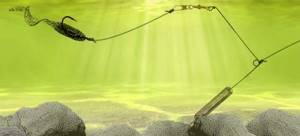
It should be noted that for better sensitivity you can use not only fluorocarbon fishing lines, but also braided fishing line, which is distinguished by the fact that it does not stretch even with great tension that appears when fishing for pike.
As you know, even before the attack, the pike even at a long distance reacts to a bait thrown into the water, since it hesitates under water, and the prepared leash for the pike remains unattended. However, if the leader shines near the bait, this may scare away the fish as it approaches the hook.
Use of diverter leads
This predatory fish can be caught using rubber baits, therefore, the use of special retractable leashes seems relevant. A pike can get caught on a retractable leash, even if you use a 2.5 meter spinning rod. This tackle can be equipped with an inertia-free reel with a friction brake, as a result of which the device will operate accurately under light loads. Experts recommend keeping the rod extended upward while fishing.
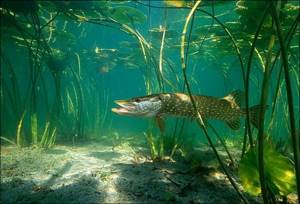
Since the attacks of this predatory fish practically occur at lightning speed, a retractable leash for pike can be used made of steel (d=0.2 mm), i.e. take a thin steel rod that can be bent to give it the appropriate shape. The presence of such a leash is a guarantee that the sharp teeth of the pike will not gnaw through the main fishing line.
When using a retractable leash, the likelihood of the bait getting caught on any object underwater is much lower. If a fluorocarbon diverter leader is used, it is quite soft, therefore, it practically does not affect the underwater play of the bait. Leashes are not intended for catching predatory fish in heavily snag areas on a mountain river with a strong current. It will also be difficult to fish in areas with a soft muddy bottom. However, if the current is not particularly strong or is completely absent, then a diversion leash will be effective. How to make a leash for a pike is no longer difficult.
Thus, retractable leashes are widely used by many anglers, without requiring much effort from the fisherman. It is important to choose the appropriate material so that the catch is successful. The leash itself can be made either independently or purchased at a specialized store. In addition, the retractable posting allows the angler not to miss the chance of catching a pike. Fishing with a retractable leash has gained great popularity due to the fact that in the vast majority of cases the fisherman will return home with a good catch. In almost all cases, the possibility of a good pike catch depends on the leash used. In this case, it is possible to use a special steel leader that communicates either with a spinner or a wobbler.
Making a diverter leash
What properties should a diverter leash have? Firstly, it ensures high sensitivity of the fishing gear used. Secondly, be strong enough to make a successful hook. The most expensive leash currently known is a model made of an alloy of titanium and nickel.
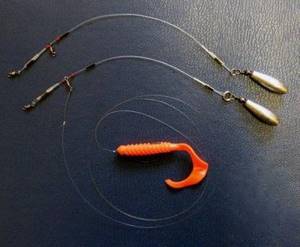
Fishing with a pike diverter leash is possible at a fairly large depth. If you use a diverter leash for pike when fishing, installation of the equipment involves the use of a sinker, the weight of which can reach 30 grams. Of course, if there is a current at the intended fishing location, it does not seem entirely relevant to use light weight sinkers. It is to the end of the fishing line that it is advisable to attach a sinker, and above that there will be a leash of the fishing line where the bait will be. It is better to use a pear-shaped sinker.
Depending on the type of bait the fisherman is using, an appropriate leader can be used. A rigid type of leash is perfect if you are fishing with jerkbaits, which are a fairly bulky plastic bait. In addition, the direct use of a short and stiff rod allows the fisherman to cast moderately heavy baits without difficulty.
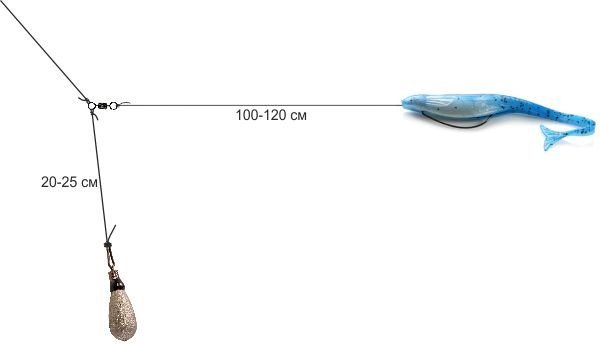
Making leashes for pike fishing is quite simple. To do this you will need a metal leash, pliers, a screwdriver and wire cutters. The entire process takes relatively little time (a few minutes). Wire cutters and a screwdriver will be needed to create a loop where you should attach one swivel, maybe 5 numbers. The output should be a product that, in terms of functional features, will not be inferior to the store-bought version. In order not to use any auxiliary equipment elements when directly attaching the leash, you can use a method such as a loop in a loop. So, we figured out what to make a leash for a pike from. Let's consider this question: which leashes are best for catching pike?
Which leashes to use when
Different leader materials are used depending on the activity of the fish and the type of bait used. A leash on a spinning rod when fishing with wobblers and silicone baits requires plasticity, influencing the movements of the rig to the least extent. Here, Kevlar, tungsten and fluorocarbon are the priority applications. When fishing with girders and winter stakes, soft leashes are quickly twisted into a spiral by live bait, making them noticeable to predators and thereby reducing fishing efficiency.
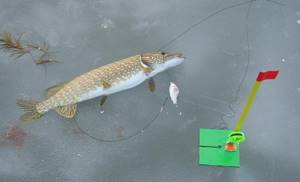
In such conditions, steel and titanium accessories will be much more practical and effective than soft materials. Having determined the activity of the fish during fishing, the leash materials are adjusted, with passive fish switching to soft and inconspicuous options, for which fluorocarbon is suitable, and under some conditions, a double leash made of nylon fishing line. The high activity of the predator does not prevent the installation of coarse steel products, making such a choice based only on the reliability of the equipment.
The role of the leash
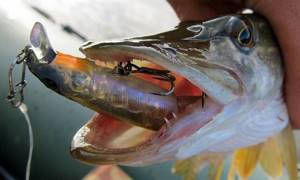
Initially, a strong leash (in the very first versions, made of wire) was designed to prevent a pike or some other predator from biting the fishing line . It was a pity to lose the artificial bait. Later they noticed that when fishing with live bait, the leash can successfully play the role of a sinker and even allow the baitfish to be in the water column in a more natural state. That is, this tackle to some extent made it easier to catch large specimens.
Another reason for using leashes may be the bottom of the reservoir. If there are a lot of shells and sharp stones on it, the line can quickly fray after several casts. The leash will pass such a test with success.
True, he himself often actively clings to the unevenness of the bottom, this must be taken into account.
Expert opinion
Knipovich Nikolai Mikhailovich
Zoologist, hydrobiologist. I am interested in fishing at a professional level.
Important! However, many anglers claim that a leader reduces the number of bites because it is much more visible than a fishing line. This is especially true in clear water during river fishing.

